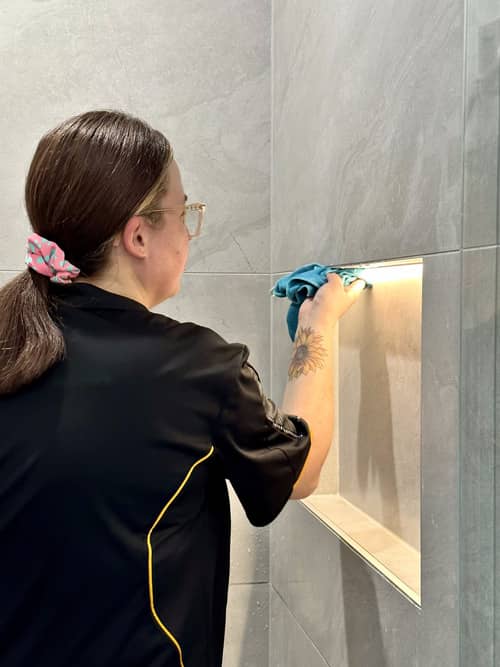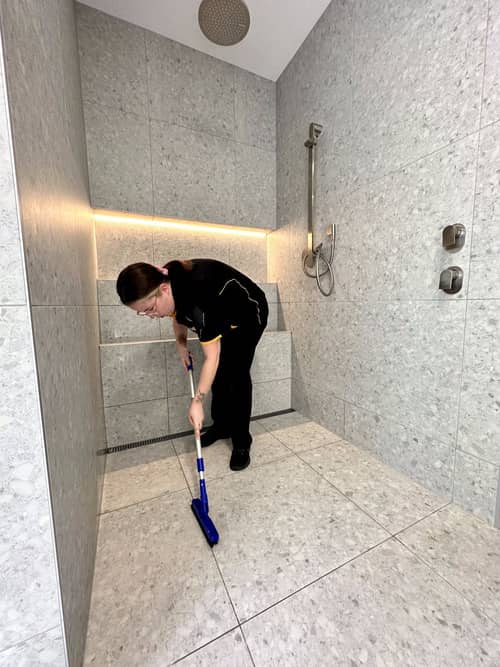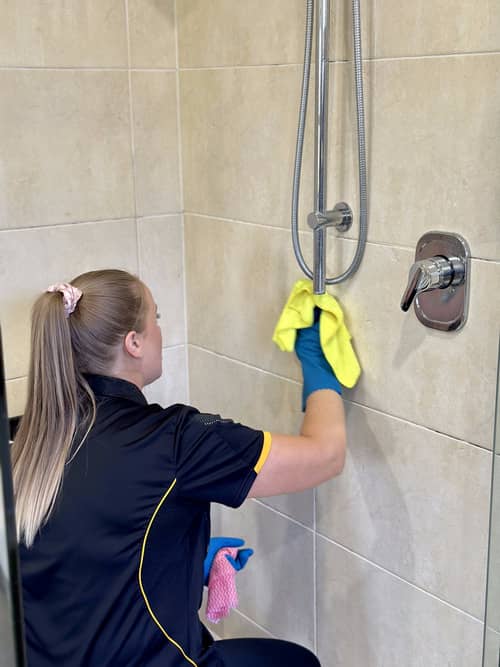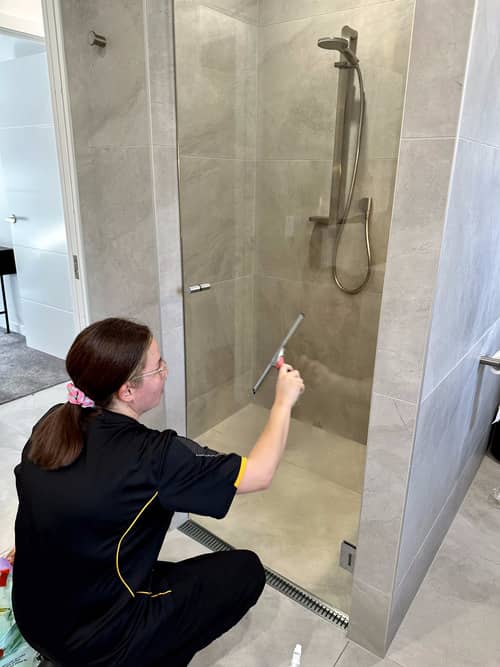I remember an old conversation with a friend about her mother’s odd cleaning habits.
She told me how her mother would not let her out of the bathroom until she had used a squeegee to clean the shower door and walls!
Now that I’m a little older, I realise that was actually solid advice.
While there’s no one correct way to clean a shower, there are wrong ways to do it.
Let’s dive into how to clean a shower, whether it’s made of tile, stone, glass or something else.
Shower Cleaning Tools
Here’s what you need to clean a shower:
- A squeegee
- Soft-bristled brush or sponge
- Microfibre cloth
- A pair of rubber gloves
- A bucket or spray bottle for mixing your cleaning solutions
- Distilled white vinegar
- Clean water
- A dedicated shower cleaner, depending on the material of your shower
- Optional: An extendable scrub brush
Cleaning Different Types of Showers
How to clean fibreglass and acrylic showers

These showers require gentle care to prevent scratches.
- Prepare the shower area: Remove all personal items and run hot water to loosen debris.
- Apply a gentle cleaner: Use a shower cleaner designed for fibreglass and acrylic. Spray or apply it evenly across the shower surfaces.
- Do some soft scrubbing: Gently scrub with a non-abrasive sponge or cloth. Circular motions can help lift grime without scratching the surface.
- Clean your shower screen: Spritz shower screens with a diluted vinegar solution, let it sit for a few minutes, then wipe it clean with a squeegee for a streak-free finish.
- Rinse thoroughly: Use a handheld showerhead or bucket to rinse off the cleaner, ensuring no residue is left behind.
- Dry and polish: To prevent water spots, dry the surfaces with a soft towel and polish with a microfiber cloth for extra shine.
How to clean a tile shower
- Remove soap scum: Start with a white vinegar and water solution to break down soap scum on the tiles.
- Grout cleaning: For grout lines, use a baking soda paste and a grout brush to scrub away mildew and stains.
- Deep clean for grout: Mix bleach with water to clean grout that is heavily stained (ensure proper ventilation).
- Rinse off the cleaning agents: Rinse the tiles and grout lines thoroughly with warm water after scrubbing.
- Wipe down the tiles: Use a clean, dry cloth to wipe down the tiles to a shine and prevent mildew.
How to clean a stone shower

- Choose the right cleaner: Select a pH-neutral cleaner formulated for natural stone.
- Apply the cleaner: Spray or gently apply the cleaner on stone surfaces, avoiding any pooling of the liquid.
- Gentle scrubbing: Use a soft sponge to carefully clean the stone surfaces without scratching them.
- Rinse with care: Rinse the stone with warm water, making sure to remove all traces of the cleaner.
- Dry the stone: Pat the stone dry with a soft cloth to prevent watermarks and mineral deposits.
How to Clean Different Shower Parts
Keeping your shower clean is essential for any bathroom.
Here’s a step-by-step guide to making each area of your shower sparkle, whether it’s your daily tidy-up or a deep clean.
Prep your shower for cleaning
Begin by removing all your shampoo bottles, soaps, and other items from the shower.
Run hot water for a few minutes to steam up the shower and loosen dirt and grime.
This makes your cleaning products more effective.
Clean shower curtains and liners

If you have a shower curtain or liner, take it off before you clean your shower.
They can be breeding grounds for mould and mildew.
Most fabric curtains and plastic liners can be cleaned in the washing machine.
Add a couple of towels to help scrub them clean, and hang them to dry to prevent wrinkles.
Choose a cleaning solution
You can make a simple yet effective shower cleaning solution with ingredients from your pantry.
Mix equal parts white vinegar and water in a spray bottle.
Or you can use a commercial product – check out our list of recommended shower cleaners.
Scrub your shower

Apply your homemade cleaning solution to the shower screen, walls and floor.
Let it sit for a few minutes to break down the dirt and soap scum.
Then, take your soft-bristled brush or sponge and scrub the tiles.
Don’t forget to scrub the grout lines thoroughly, as this is where mould and mildew tend to thrive.
Clean hard water spots
If you notice limescale or other hard water spots, spray those areas with diluted white vinegar and let the solution sit for a few minutes.
Rub off the white vinegar mixture with a soft cloth, then dry and polish with a microfiber towel.
Scrub off soap scum
Cleaning soap scum in your shower needs a different approach.
Apply a mixture of equal parts dish soap and white vinegar and let sit for 15 minutes.
Scrub it off with a soft sponge and rinse.
Clean grout lines and tiles

Grout lines and tiles can be notorious for collecting grime and mildew, but a deep clean can restore them to their original lustre.
Mix three parts baking soda with one part water to make a thick cleaning paste.
Let the mixture sit for five to ten minutes, then use a grout brush or an old toothbrush to scrub your shower’s grout lines and tiles gently.
If your grout lines are orange or any other colour, you’ll need a different approach and might also need professional help to clean them.
There are two common causes for orange grout stains in showers: iron (hard water) and pink mould.
You can clean orange grout caused by hard water with white vinegar or lemon juice.
If it’s caused by pink mould, consult a cleaning expert or health professional.
Clean your shower head

A clean shower head means consistent water flow and no mineral deposits or other gunk in its nozzles.
If your shower head can be removed, unscrew it from the hose or pipe and prep a bowl of white vinegar.
If it’s a fixed type, you’ll need a plastic bag and enough white vinegar to fully submerge the shower head.
You’ll need to let the shower head soak for at least 30 minutes before rinsing it out.
Rinse down the shower and the shower floor
After scrubbing and washing each part, thoroughly rinse the entire shower with warm water.
If you have a handheld shower head, use it to direct the water flow and ensure you wash away all the cleaning solution.
A clean bucket of water for fixed shower heads will do just fine.
Oh! Make sure you rinse your shower drain, too. A cup of hot water will do the trick.
Optional – dry and polish your shower
You can leave your shower to air dry or use a clean microfiber cloth to wipe away the excess water.
Use another microfiber cloth to gently polish your shower walls after they’re dry.
How to Keep a Shower Clean
Keeping a clean shower is easier than you might think.
Here are some tips to keep your shower spotless between deep cleanings.
Daily Maintenance

Cleaning your shower right after each use helps keep your shower clean in the long run.
- Use a squeegee: After every use, take a minute to squeegee the water off the shower walls and door. This step will drastically reduce water spots and soap scum build-up.
- Quick spray: Keep a daily shower cleaner or a homemade solution of water and vinegar in the bathroom. A quick spray-down after the last shower of the day can make a big difference.
- Ventilate: Always ventilate the shower area well after use. An exhaust fan or an open window can help reduce moisture and prevent mildew.
Weekly Spot Cleaning
Sometimes, a weekly cleaning can help you keep a sparkling clean shower.
- Address spots promptly: Tackle soap scum or water spots on glass doors or walls once a week with a vinegar solution.
- Check drains and faucets: Wipe down and check drains and faucets for any limescale or mineral build-up, and treat as needed with a vinegar soak.
- Wash bath mats: Don’t forget to wash any bath mats or rugs regularly to keep them fresh and free from mildew.
Monthly Deep Cleaning
Like any other part of your home, your shower (and bathroom) needs to be deep cleaned once a month.
- Deep scrub: Once a month, thoroughly scrub down your shower. Be sure to check the grout and any hidden areas that might harbour mould.
- Inspect sealant and grout: Check the sealant and grout for any signs of wear or damage. Repair or replace as needed to prevent water damage.
- Organise shower supplies: Take this opportunity to declutter your shower space and throw out empty bottles or rarely used products.
Clean Shower, Cleaner You
With the right tools, cleaning solutions, and a bit of elbow grease, your shower can remain a clean and refreshing space.
Include these cleaning and maintenance tips into your routine, and you’ll be on your way to a consistently clean and inviting shower.
Of course, you can always call professional cleaners to help when life becomes overwhelming.

